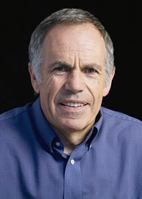Champaign, Illinois
November 12, 2007
 |
In a computer model,
researchers at Illinois were able to simulate the
photosynthetic behavior of actual leaves. Here, a gas
exchange system measures the rate of carbon dioxide and
electron transport in intact leaves
Photo by Don Hamerman |
University of Illinois researchers have built a better
plant, one that produces more leaves and fruit without needing
extra fertilizer. The researchers accomplished the feat using a
computer model that mimics the process of evolution. Theirs is
the first model to simulate every step of the photosynthetic
process.
The research findings appear in the October issue of Plant
Physiology, and will be presented today at the BIO-Asia 2007
Conference in Bangkok, Thailand. The research was sponsored by
the National Science Foundation.
Photosynthesis converts light energy into chemical energy in
plants, algae, phytoplankton and some species of bacteria and
archaea. Photosynthesis in plants involves an elaborate array of
chemical reactions requiring dozens of protein enzymes and other
chemical components. Most photosynthesis occurs in a plant’s
leaves.
“The question we wanted to ask, was, ‘Can we do better than the
plant, in terms of productivity?’ ” said principal investigator
Steve Long, a professor of
plant biology
and crop sciences at
the University of Illinois.
It wasn’t feasible to tackle this question with experiments on
actual plants, Long said. With more than 100 proteins involved
in photosynthesis, testing one protein at a time would require
an enormous investment of time and money.
“But now that we have the photosynthetic process ‘in silico,’ we
can test all possible permutations on the supercomputer,” he
said.
The researchers first had to build a reliable model of
photosynthesis, one that would accurately mimic the
photosynthetic response to changes in the environment. This
formidable task relied on the computational resources available
at the National Center for
Supercomputing Applications.
Xin-Guang Zhu, a research scientist at the center and in plant
biology, worked with Long and Eric de Sturler, formerly a
specialist in computational mathematics in computer sciences at
Illinois, to realize this model.
|
 |
“The question we wanted to
ask, was, ‘Can we do better than the plant, in terms of
productivity?’ ” said principal investigator Steve Long,
a professor of plant biology and crop sciences at
Illinois.
Photo by L. Brian Stauffer |
After determining the relative
abundance of each of the proteins involved in photosynthesis,
the researchers created a series of linked differential
equations, each mimicking a single photosynthetic step. The team
tested and adjusted the model until it successfully predicted
the outcome of experiments conducted on real leaves, including
their dynamic response to environmental variation.
The researchers then programmed the model to randomly alter
levels of individual enzymes in the photosynthetic process.
Before a crop plant, like wheat, produces grain, most of the
nitrogen it takes in goes into the photosynthetic proteins of
its leaves. Knowing that it was undesirable to add more nitrogen
to the plants, Long said, the researchers asked a simple
question: “Can we do a better job than the plant in the way this
fixed amount of nitrogen is invested in the different
photosynthetic proteins?”
Using “evolutionary algorithms,” which mimic evolution by
selecting for desirable traits, the model hunted for enzymes
that – if increased – would enhance plant productivity. If
higher concentrations of an enzyme relative to others improved
photosynthetic efficiency, the model used the results of that
experiment as a parent for the next generation of tests.
This process identified several proteins that could, if present
in higher concentrations relative to others, greatly enhance the
productivity of the plant. The new findings are consistent with
results from other researchers, who found that increases in one
of these proteins in transgenic plants increased productivity.
“By rearranging the investment of nitrogen, we could almost
double efficiency,” Long said.
An obvious question that stems from the research is why plant
productivity can be increased so much, Long said. Why haven’t
plants already evolved to be as efficient as possible?
“The answer may lie in the fact that evolution selects for
survival and fecundity, while we were selecting for increased
productivity,” he said. The changes suggested in the model might
undermine the survival of a plant living in the wild, he said,
“but our analyses suggest they will be viable in the farmer’s
field.”
Long also is the deputy director of the
Energy
Biosciences Institute and an affiliate of the
Institute for Genomic Biology
and the supercomputing center.
Diana Yates, Life Sciences
Editor |
|